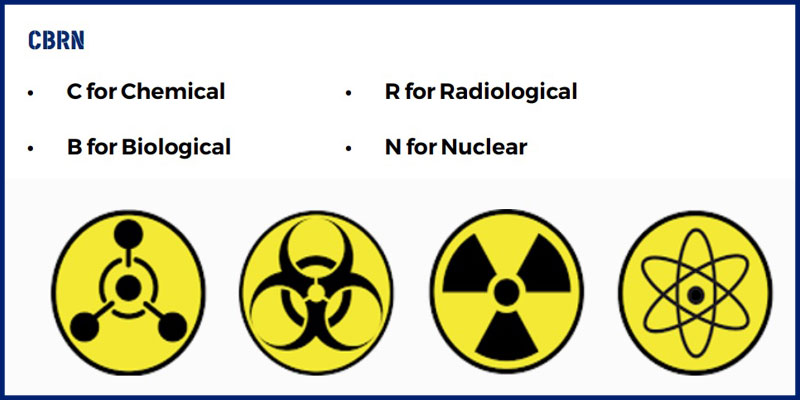- India
- Feb 27
Indian Army to procure equipment to combat chemical warfare threat
• There is an ever increasing threat of Chemical, Biological, Radiological and Nuclear (CBRN) warfare by state adversaries as well as non-State actors.
• In order to boost preparations against chemical warfare threat, Indian Army has signed a contract for procurement of 223 Automatic Chemical Agent Detection and Alarm (ACADA) systems from L&T Ltd at a cost of Rs 80.43 crore.
How it works?
• ACADA has been designed and developed by DRDO’s Defence Research and Development Establishment, Gwalior and marks a significant milestone in the nation’s indigenisation initiative in the niche CBRN domain.
• The ACADA system is used to detect chemical warfare agents and programmed toxic industrial chemicals (TICs) by sampling the air from the environment.
• It works on the principle of Ion Mobility Spectrometry (IMS) and contains two highly sensitive IMS cells for continuous detection and simultaneous monitoring of harmful/toxic substances.
• Induction of ACADA in the field units will substantially enhance Indian Army’s defensive CBRN capability for operations, as also for peacetime, especially for responding to disaster relief situations related to industrial accidents.
CBRN weapons
• The prospect of non-State actors, including terrorists and their supporters, gaining access to and using Weapons of Mass Destruction (WMD)/Chemical Biological, Radiological and Nuclear (CBRN) materials is a serious threat to international peace and security.
• Over the years, terrorist groups have tested new ways and means to acquire and use more dangerous weapons to maximise damage and incite terror, including weapons incorporating CBRN materials.
• With advancements being made in technology and the expansion of legal and illegal commercial channels, including on the dark web, some of these weapons have become increasingly accessible.
• This encompasses a wide range of agents and materials including corrosive substances, poisons, toxins, biological organisms and radioactive sources. These materials can be harmful to humans in a variety of ways when inhaled, ingested or absorbed.
• CBRN weapons have been used since antiquity. Examples of their recent use include war fighting (World War I and the Iran-Iraq War), ethnic conflict (chemical weapon use against the Iraqi Kurds and in Syria), terrorism (release of sarin in the Tokyo underground, US anthrax letters) and assassination (ricin, polonium-210).
• In addition, CBRN incidents have also included accidental releases during peacetime operations, and many of the principles for CBRN incident response can be applied to other hazardous material (HAZMAT) incidents.
• The impact of such weapons may have a range of implications for medical personnel both military and civilians.
• Chemical: Poisoning or injury caused by chemical substances, including household chemicals or harmful industrial chemicals, as well as agents used during armed conflict.
• Biological: Exposure to harmful bacteria, viruses or toxins and the illness or disease they cause.
• Radiological: Exposure to harmful radioactive materials.
• Nuclear: Exposure to thermal or blast effects arising from a nuclear detonation (including secondary effects from radioactive fallout). Release of the energy resulting from a nuclear chain reaction. For example, nuclear power plant accidents, such as Chernobyl and Fukushima.
Countering CBRN weapons
• The risk of chemical, biological, radiological and nuclear (CBRN) weapons or related materials being used by non-State actors for terrorist or other criminal purposes is one of the gravest concerns of our time. In response, the international community is pursuing a common legislative framework to counter this threat.
Seven of the 19 international legal instruments against terrorism deal, to varying degrees, with CBRN terrorism:
i) 1980 Convention on the Physical Protection of Nuclear Material.
ii) 1997 International Convention for the Suppression of Terrorist Bombings.
iii) 2005 International Convention for the Suppression of Acts of Nuclear Terrorism.
iv) 2005 Amendment to the Convention on the Physical Protection of Nuclear Material.
v) 2005 Protocol to the Convention for the Suppression of Unlawful Acts against the Safety of Maritime Navigation.
vi) 2005 Protocol to the Protocol for the Suppression of Unlawful Acts against the Safety of Fixed Platforms located on the Continental Shelf.
vii) 2010 Convention on the Suppression of Unlawful Acts relating to International Civil Aviation.
• The promotion of the universal adoption and effective implementation of these legal instruments is among United Nations Office on Drugs and Crime’s (UNODC) highest priorities.
• By incorporating the seven international legal instruments related to CBRN terrorism into national legislation, the UN Member States are better able to fufil their obligations set forth by United Nations Security Council resolution (2004) on the risk of proliferation of nuclear, chemical and biological weapons by non-State actors.
Manorama Yearbook app is now available on Google Play Store and iOS App Store


